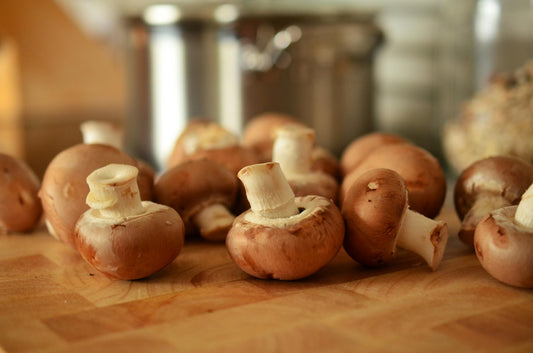Table of Contents
Lately, the extract of Spermidine, a naturally occurring polyamine, has gained significant attention for its potential anti-aging benefits. But did you know some everyday foods are rich in this powerful compound?
Let’s examine which foods are high in Spermidine and consider the potential benefits of incorporating more of them into your diet.
SPERMIDINE
Cellular autophagy activator, providing a potent and highly purified dose of Spermidine.*
What Is Spermidine?
Spermidine is critical in cellular health and may even have anti-aging properties. Studies show that Spermidine may support longevity by promoting autophagy, a process through which cells remove damaged components. [1]
Our diet can naturally increase Spermidine levels. Rather than relying solely on supplements, incorporating foods with high Spermidine levels, like wheat germ and soybeans, can ensure a natural intake. Including these foods in daily meals helps you harness Spermidine’s benefits naturally.
5 Foods High in Spermidine
-v1738351525951.webp) Incorporating Spermidine-rich foods into our diet can promote cellular health and longevity. Below are the top foods high in Spermidine content.
Incorporating Spermidine-rich foods into our diet can promote cellular health and longevity. Below are the top foods high in Spermidine content.
Wheat Germ
Wheat germ, which contains about 243 mg/kg of Spermidine (or about 2.5 mg per tablespoon), derives from the embryo of wheat kernels and is rich in essential nutrients. Adding wheat germ to cereals, smoothies, or baked goods can boost your Spermidine intake.
Soybeans
Soybeans are another excellent Spermidine source, containing between 165 and 290 mg/kg. To consume more soybeans, reach for edamame, tofu, or soy milk.
Mushrooms
Mushrooms have substantial Spermidine levels, with Black Shimeji being exceptionally high in Spermidine content. These unique mushrooms have roughly 124 mg/kg of Spermidine. Try incorporating them into salads, soups, or stir-fries. [2]
Legumes
Legumes such as lentils, chickpeas, and peas are Spermidine-rich and offer additional nutritional benefits. Green peas contain about 50 mg/kg of Spermidine, or about 8 mg per cup. Try including legumes in soups, stews, or salads to boost Spermidine and other essential nutrients.
Mangos
Mangos contain several beneficial components, including vitamin A, polyphenols, and roughly 30 mg/kg of Spermidine, or about 5 mg per cup of mango.
Benefits of Spermidine
Research has shown that Spermidine offers numerous health benefits.
Cellular Health
Animal studies show that Spermidine promotes autophagy, helping cells remove damaged components. This process improves cellular function, reduces oxidative stress, and lowers inflammation, contributing to longevity and better overall health. [3]
Longevity and Aging
Spermidine is linked to increased lifespan and anti-aging effects in animal studies. In humans, regular consumption of Spermidine-rich foods like soybeans and aged cheese has been linked to a delay in the signs of aging, including skin dryness and hair loss in observational studies. [4]
Cognitive Function
There is interest in Spermidine as a potential supplement to support brain health. A study published in 2022 gave 1mg of Spermidine for 12 months to people with cognitive decline. The results showed no significant improvement. Researchers suggest the dose may be too small. Another study used a higher dose of Spermidine and reported a significant memory improvement. More research is ongoing, and the jury is still out on whether Spermidine can support cognitive function. [5][6]
Women who take Spermidine may experience benefits. Spermidine may promote healthy aging, a concern for many women as they age.
Incorporating Spermidine-Rich Foods Into Your Diet
Incorporating Spermidine-rich foods into your daily meals is a simple yet powerful way to boost cellular health and support longevity. Here are some practical and delicious ways to get started.
Meal Ideas
- Breakfast options: Start your day with a nutrient-rich breakfast. Add wheat germ to your oatmeal or yogurt. Soy milk can be used in smoothies or cereal, providing a quick Spermidine boost.
- Lunch suggestions: Add mushrooms and legumes like lentils and chickpeas to your soups or grain bowls.
- Dinner plans: Integrate Spermidine-rich foods at dinner by preparing stir-fries with soybeans and mushrooms.
Recipes
Wheat Germ Oatmeal
- Ingredients: 1 cup rolled oats, 2 tbsp wheat germ, 1 cup soy milk, honey, berries.
- Instructions: Cook oats with soy milk. Stir in wheat germ and top with honey and berries.
Mushroom and Lentil Salad
- Ingredients: 1 cup cooked lentils, 1 cup sliced mushrooms, 2 cups mixed greens, olive oil, lemon juice.
- Instructions: Sauté mushrooms until tender. Toss cooked lentils and mushrooms with mixed greens. Drizzle with olive oil and lemon juice.
Soybean Stir-Fry
- Ingredients: 1 cup cooked soybeans, 1 bell pepper, 1 cup broccoli florets, 2 tbsp soy sauce, 1 clove garlic, 1 tbsp sesame oil.
- Instructions: Sauté garlic in sesame oil. Add bell pepper and broccoli and stir-fry until tender. Stir in soybeans and soy sauce and cook for an additional 3-4 minutes.
Potential Side Effects and Considerations
Some individuals — particularly those with gluten intolerance — may experience side effects from high-spermidine foods, such as bloating or diarrhea, especially if they consume it in large amounts too quickly. Gradual introduction can help reduce digestive discomfort. The best food source of Spermidine is wheat germ, which will naturally contain gluten given its source.
Allergic reactions are also possible, particularly with common allergens like soybeans and mushrooms. People with food allergies or those on medications should consult a healthcare provider before increasing their Spermidine intake, as it may interact with certain drugs. Individuals with celiac disease who can’t tolerate gluten should avoid gluten-rich sources of Spermidine.
Additionally, foods like wheat germ are calorie-dense, so that over-consumption can lead to weight gain. Opting for organic or non-GMO options and using the best supplements that meet high-quality standards can help you get the benefits of Spermidine while minimizing risks. Moderation and balance are essential to safely incorporating Spermidine-rich foods and supplements into your diet.
SPERMIDINE
Cellular autophagy activator, providing a potent and highly purified dose of Spermidine.*
Frequently Asked Questions
What is Spermidine?
Spermidine is a natural polyamine found in various foods. It supports cellular health and autophagy and has potential anti-aging benefits.
Which foods are rich in Spermidine?
Spermidine is high in foods like wheat germ, soybeans, mangos, mushrooms, lentils, and chickpeas.
How can I include Spermidine-rich foods in my diet?
To easily include Spermidine-rich foods, add wheat germ to your oatmeal, use soybeans and mushrooms in dinner dishes, or make lentil-based soups.
Are there any side effects to consuming high-Spermidine foods?
Although rare, side effects can include digestive discomfort and allergic reactions. To avoid rapid weight gain, eat spermidine-rich foods that are also calorie-dense, such as wheat germ, in moderation.
Can everyone benefit from Spermidine-rich foods?
Nearly everyone can benefit from incorporating more healthy, Spermidine-rich foods like mushrooms and legumes into their diets. Take care to limit spermidine-rich foods that are less healthy, like aged cheeses. If you have allergies, medical conditions, or dietary restrictions, consult a healthcare provider before increasing your intake.
How can I minimize the risks of consuming high-Spermidine foods?
There are no risks to incorporating high-Spermidine foods into your daily diet.





